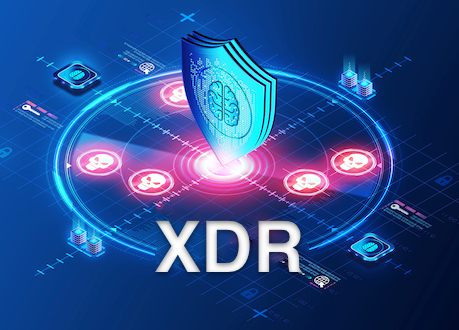If you’re anything like me, then hearing the term "Extended Detection Response (XDRExtended Detection and Response (XDR) is an advanced security solution that goes beyond traditional endpoint detection and response (EDR) and network detection and response (NDR) by integrating various security products into a cohesive security operation. XDR collects and automatically correlates data across multiple security layers – email, endpoint, server, cloud workloads, and network – enabling improved threat detection, incident response, and security operations.
See More...
See Less...
)" might induce an involuntary eye roll. The term initially felt like yet another buzzword, coined ambiguously and brandished without a clear definition.
Pose the question, "What is XDR?" to a group, and you'd likely be met with a myriad of differing answers, each as vague as the next. Over time, however, as with its counterparts NDRNetwork Detection and Response (NDR) is a cybersecurity solution focused on monitoring and analyzing network traffic to detect and respond to suspicious activities and potential threats. NDR tools use advanced analytics, including AI and machine learning, to identify abnormal traffic patterns or behaviors that may indicate a security threat.
See More...
See Less...
and EDREndpoint Detection and Response (EDR) is a cybersecurity technology that addresses the need for continuous monitoring and response to advanced threats. It focuses on endpoint devices like computers, mobile phones, and servers. EDR platforms provide real-time monitoring and data collection capabilities, as well as tools for analyzing, detecting, and responding to cyber threats.
See More...
See Less...
, t he term XDR has cemented its place in the cybersecurityCybersecurity refers to the practice of protecting computers, networks, programs, and data from unauthorized access, damage, or attack. It involves a range of strategies and technologies designed to safeguard digital assets from cyber threats like hacking, viruses, and data breaches. Cybersecurity measures are essential to prevent sensitive information from being stolen or tampered with, and to ensure the smooth functioning of digital systems. This field is increasingly important in our connected world, where a lot of personal, financial, and business activities are conducted online.
See More...
See Less...
lexicon. The consensus? XDR is essentially about the 'analysis of stuff.' As unspecific and, let's admit, slightly exasperating as that sounds, it's become our industry's standard.
he term XDR has cemented its place in the cybersecurityCybersecurity refers to the practice of protecting computers, networks, programs, and data from unauthorized access, damage, or attack. It involves a range of strategies and technologies designed to safeguard digital assets from cyber threats like hacking, viruses, and data breaches. Cybersecurity measures are essential to prevent sensitive information from being stolen or tampered with, and to ensure the smooth functioning of digital systems. This field is increasingly important in our connected world, where a lot of personal, financial, and business activities are conducted online.
See More...
See Less...
lexicon. The consensus? XDR is essentially about the 'analysis of stuff.' As unspecific and, let's admit, slightly exasperating as that sounds, it's become our industry's standard.
So, why pen an entire article on a term that initially seemed like mere jargon? Because, beneath its nebulous exterior, the core principle of analyzing diverse data sources is paramount in our rapidly changing digital landscape.
What is XDR?
Extended Detection and Response (XDR)Extended Detection and Response (XDR) is an advanced security solution that goes beyond traditional endpoint detection and response (EDR) and network detection and response (NDR) by integrating various security products into a cohesive security operation. XDR collects and automatically correlates data across multiple security layers – email, endpoint, server, cloud workloads, and network – enabling improved threat detection, incident response, and security operations.
See More...
See Less...
is a holistic cybersecurity approach that seamlessly integrates and automates threat detection, analysis, and response across various layers of an organization's security setup. By bringing together information from different areas, such as endpoints, networksA collection of interconnected computers, servers, and other devices that allow for the exchange and sharing of data and resources. Networks can be classified based on size, function, and access. Common types include Local Area Network (LAN), which connects devices in a localized area such as an office or home; Wide Area Network (WAN), which connects devices across large distances, possibly globally; and Virtual Private Network (VPN), which provides secure, encrypted connections over the internet. A network relies on standardized protocols, such as TCP/IP, to ensure uniform communication and data transfer between devices.
See More...
See Less...
, cloudThe cloud refers to servers that are accessed over the Internet, and the software and databases that run on those servers. Cloud servers are located in data centers all over the world. By using cloud computing, individuals and companies don't have to manage physical servers themselves or run software applications on their own machines.
See More...
See Less...
services, and emails, XDR offers a clearer and more comprehensive view, enhancing the efficiency of responding to threats.
Why Does XDR Hold Such Significance?
In an era where cyber threats grow in complexity and frequency, XDR stands as a pivotal tool for robust cybersecurity.
- Bridging the Visibility Gap: Traditional security architectures, while functional, often work in isolated compartments. XDR bridges this gap, aggregating dataData, in everyday terms, refers to pieces of information stored in computers or digital systems. Think of it like entries in a digital filing system or documents saved on a computer. This includes everything from the details you enter on a website form, to the photos you take with your phone. These pieces of information are organized and stored as records in databases or as files in a storage system, allowing them to be easily accessed, managed, and used when needed.
See More...
See Less...
to paint a coherent picture, thus enhancing threat-hunting capabilities.
- Acceleration in Threat Response: Powered by AIA branch of computer science that focuses on creating systems capable of performing tasks that typically require human intelligence. These tasks include learning, reasoning, problem-solving, perception, and language understanding. AI can be categorized into narrow or weak AI, which is designed for specific tasks, and general or strong AI, which has the capability of performing any intellectual task that a human being can.
See More...
See Less...
and MLMachine Learning is a subset of artificial intelligence (AI) focused on building systems that learn from data. It enables computers to improve their performance on a specific task with data, without being explicitly programmed. This involves algorithms that can identify patterns, make decisions with minimal human intervention, and predict outcomes based on historical data.
See More...
See Less...
, XDR processes vast data setsA collection of related data, often in a structured form, used for analysis, research, or information processing. Data sets can vary in size and complexity, ranging from simple lists to large databases.
See More...
See Less...
at breakneck speeds, facilitating near-instantaneous threat detection and response, minimizing potential fallout.
- Refinement in Security Workflow: By orchestrating various security components and automating routine tasks, XDR refines operational efficiency. This streamlining allows security personnel to prioritize critical tasks, bypassing manual redundancies.
- Contextual Intelligence: By combining data from various sources, XDR offers a clearer understanding of how events are related, making it easier to spot and understand coordinated threats.
- Optimizing ROIA financial metric used to evaluate the efficiency or profitability of an investment. It compares the gain from an investment relative to its cost, typically expressed as a percentage. This measurement helps in assessing the potential return from a specific investment or comparing the efficiency of different investments.
See More...
See Less...
: XDR's integration prowess not only amplifies security efficacy but also boosts ROI, minimizing threat management expenditures.
The XDR Paradigm Shift in Cybersecurity
The influence of XDR on modern cybersecurity practices is multifaceted:
- Eradicating Operational Silos: Implemented correctly, XDR fosters a spirit of cohesion, integrating varied security tools and promoting inter-team collaboration, thus dispelling traditional operational silos.
- Harnessing the AI & ML Wave: Infusing AI and ML into XDR augments its threat detection and countermeasure potential, staying a step ahead of cyber adversaries.
- Pioneering Preventive Measures: XDR's predictive capabilities empower security teams to transition from mere reactionaries to threat anticipation and mitigation strategists.
- Fortifying Cyber Resilience: With a 360-degree view and enhanced counteraction capabilities, XDR is instrumental in bolstering an organization's defenses against sophisticated attacks.
- Demystifying Cybersecurity: XDR's comprehensive approach streamlines cybersecurity, making it easier to manage diverse IT systems.
In today's cybersecurity landscape, where threats are ever-evolving and becoming more sophisticated, the importance of embracing strategies like XDR cannot be overstated. Extended Detection and Response (XDR) is pioneering a comprehensive approach, not merely as an evolutionary step, but as a revolutionary leap in threat detection and response.
Example: Spotting an Insider Threat with XDR
In a bustling tech company, Jane, a software engineer, contemplated a change. Enticed by a competitor's offer, she thought about acquiring some proprietary data before making her move.
On a seemingly ordinary day, Jane accessed the company's Google Drive through her workstation. She opened a confidential folder and downloaded a critical project document. Subsequently, she attached this document to an email and sent it to her personal account, thinking this method would go unnoticed.
The company's integrated XDR system began piecing together the subtle signs:
- Network Monitoring via NDR: The system detected a connection request to Google Drive, followed by subsequent network traffic indicating data transfer activities.
- Integration with Google Drive: The Drive logs captured Jane's access to the confidential folder and her downloading of a specific file.
- Email Logs Integration: The email logs revealed an outbound email from Jane's official account to an external, personal address. Notably, the attachment's metadata, such as its name and type, matched the file she accessed on Google Drive.
However, had Jane chosen a different approach, she might have opted to download the proprietary data directly to a USB drive. This act, while seemingly more covert, wouldn't escape notice:
- Endpoint Detection via EDR: The EDR tool would have identified a significant data transfer attempt to an external USB device from Jane's workstation.
In isolation, these actions might come across as routine. However, XDR, with its capability to gather data from various sources, detected the irregularity. By consolidating insights from network activities, cloud platforms, email logs, and endpoints, the system pinpointed a probable insider threatA security risk that originates from within the targeted organization, typically involving current or former employees, contractors, or business associates who have inside information concerning the organization's security practices, data, and computer systems. An insider threat can manifest in malicious actions such as theft of proprietary information, sabotage of systems, or data breaches, as well as unintentional actions that inadvertently cause harm or expose sensitive data.
See More...
See Less...
.
The security team, alerted by these detections, was able to intervene. This incident underscores the unmatched capabilities of XDR in identifying activities that, while maybe benign when taken individually, tell a very different story when combined and analyzed by behavioral machine learningMachine Learning is a subset of artificial intelligence (AI) focused on building systems that learn from data. It enables computers to improve their performance on a specific task with data, without being explicitly programmed. This involves algorithms that can identify patterns, make decisions with minimal human intervention, and predict outcomes based on historical data.
See More...
See Less...
.
 he term XDR has cemented its place in the cybersecurity lexicon. The consensus? XDR is essentially about the 'analysis of stuff.' As unspecific and, let's admit, slightly exasperating as that sounds, it's become our industry's standard.
he term XDR has cemented its place in the cybersecurity lexicon. The consensus? XDR is essentially about the 'analysis of stuff.' As unspecific and, let's admit, slightly exasperating as that sounds, it's become our industry's standard.









